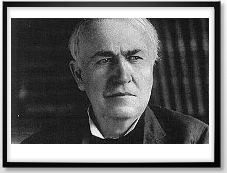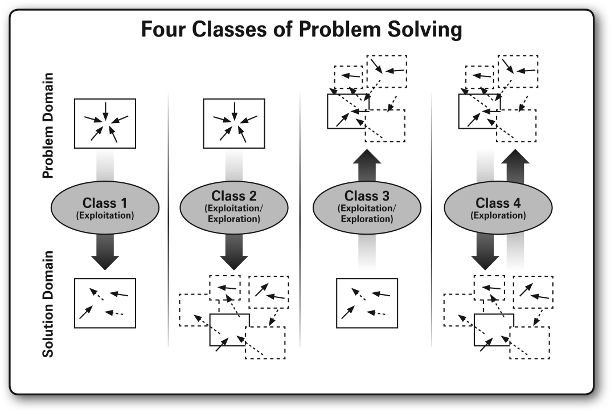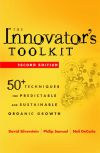How People Solve Problems
Every innovation is the result of solving some important problem. Simple problems lead to simple solutions, like using a net to catch a fish. More complex problems lead to more complex solutions, like developing a naval ship to get an army across an ocean, or building a rocket to reach outer space. Still other problems lead to solutions that save lives: vaccines, portable water purifiers, bulletproof vests and the like.
In all of these diverse cases, the underlying problem-solving dynamics are the same: People either converge in their thinking to solve a problem or they diverge in their thinking to solve a problem—or they do both.
Convergent vs. Divergent Thinking
Each stage of the problem-solving process is associated with two fundamental cognitive operations, namely divergent thinking and convergent thinking. The divergent thinking operation involves searching for ideas and increasing one’s options through elaboration of the problem, redefinition of the problem, and by exploring, connecting, and/or combining potential ideas and solutions.
In contrast, the convergent thinking operation involves evaluating ideas and narrowing or reducing one’s options through the imposition of value judgments, exploiting the information available about the ideas, and then prioritizing and selecting. In both cases (divergent and convergent thinking), the resulting ideas and solutions may fall inside, at the edges of, or outside the relevant technical domain or paradigm.
It’s important to note that divergent thinking is not considered synonymous with out of the box thinking, nor convergent thinking with in the box thinking. All problem solvers both diverge and converge, at different cognitive levels and with different preferred styles; these operations lead to solutions throughout the problem-solving space.
Exploitation vs. Exploration
Another way to look at the problem-solving approach is in terms of exploration versus exploitation. Exploration is about searching for new ideas both inside and outside the paradigm, whereas exploitation is about taking advantage of an idea within the paradigm and perfecting it. Some business problems require mostly exploitation, while others require mostly exploration, but all problems require some mixture of the two.
Thomas Edison is often called an inventor, but he mostly developed basic discoveries into better solutions for commercialization. Often credited with inventing the lightbulb, Edison really conducted extensive experimentation and analysis to find the optimal conditions under which the tungsten wire in a bulb would glow continuously without interruption. While Edison did his own share of exploration, his basic strength and passion was in taking what was already known and refining it until it could solve some known problem.
Einstein, on the other hand, thought mostly outside the box of his day’s prevailing wisdom, or what was known at the time, and such exploration is the essence of solving problems in untried and untested ways. His theory of relativity questioned key assumptions of Newtonian physics. Einstein even characterized himself as a little strange—but strangeness is what it takes to solve ill-defined problems, or to solve fairly well-defined problems in new and unusual ways.

Thomas Edison borrowed new paradigms discovered by others and preferred to perfect them methodically, systematically and in a precise manner. Edison was more of an adaptor.

Albert Einstein questioned the existing Newtonian paradigm, which enabled him to discover the theory of relativity. Einstein was more of an innovator.
People in your organization, including you, are either more like Edison or more like Einstein. You might tend to solve problems through study, analysis, and working within known domains (exploitation). Or you might tend to explore new domains, question assumptions, and generate many hair-brained ideas until you solve your problem (exploration). (Read more about problem-solving styles in “Creativity Is Everywhere and for Everyone.”)
To reiterate, different types of innovation problems require different degrees of exploitation and exploration to solve (see exhibit below).The solid boxes and lines represent the convergent exploitation, while the dotted boxes and lines represent divergent exploration.

Four Classes of Problem Solving
Understanding each of these four problem-solving classes will enable you to characterize any problem in your organization. From there you can select the best and most appropriate techniques for solving your particular problem:
Class 1—The problem and the solution space are both well-defined, and this dictates mostly exploitation activities within the current paradigm. Defects on a production line are a good example of Class-1 problems, which are usually solved with such process-improvement methods as Plan-Do-Check-Act (PDCA), Six Sigma, Lean and the like.
Class 2—The problem is well defined but the solution pathway is not so clear or directly discoverable. Therefore, the task is to explore new ideas and realms, searching for better solutions, while also exploiting known knowledge when necessary. For example, the job of illuminating a room in the dark was once accomplished with a candle, but candles have drawbacks, like dripping wax. Some important customer expectations were not met very well by candles, so this opened the door for better solutions.
Discover or invent a better solution that closes the dissatisfaction gap.
When your customers tell you they are largely satisfied with your product or service, you have a Class-1 problem: Just optimize. If, on the other hand, customers tell you they are unsatisfied with your product or service, you have a Class-2 problem: Discover or invent a better solution that closes the dissatisfaction gap. Stated differently, if customers are generally happy with candles, make better candles; if they are unhappy, discover a better way to illuminate the darkness.
Class 3—Class-3 problems are the reverse of Class-2 problems: The solution is clear but the problem is fuzzy. Class-3 problems are intriguing because they force you to consider new applications for existing technologies. For instance, engineer Richard James was working with tension springs in 1943 to develop a meter for monitoring horsepower on naval battleships. One of his springs fell to the ground and gave him a new idea about a different Job To Be Done in a different market. Thus the Slinky was born.
Sometimes, your existing solutions can be put to a different use, thereby solving a problem and opening a new market. In effect, Class-3 problems require you to turn your ideation efforts upward—beyond where your solutions reside into the realm of higher human needs—asking what jobs your solutions could do that they don’t do today.
Class 4—These problems are undefined, and their solutions are undefined as well. There is no particular mandate to solve any problem, and the objective is to simply explore because both the problem and the solution reside in unknown territory. Medical researchers, for instance, are always looking for new molecules—just for the sake of finding them. Once they’re found, they can always be studied, manipulated and exploited.
Solving Class 4 problems is what you do when you don’t know what you’re doing—basic research, where discoveries are made but the path to commercialization is unclear.
Of the four problem-solving classes, Class-2 and Class-3 problems are by far the ripest ones on which to focus organic growth efforts. All 58 techniques in The Innovator’s Toolkit: 50+ Techniques for Predictable and Sustainable Organic Growth were chosen because they primarily solve these types of organic growth problems. Some of the techniques, such as Biomimicry and Design of Experiments can help the Class-4 problem solver. For more information and a sampling of techniques, visit The Innovator’s Toolkit website.

The material on this webpage is excerpted from The Innovator’s Toolkit: 50+ Techniques for Predictable and Sustainable Organic Growth (John Wiley & Sons, 2012)—authored by the Lean Methods Group’s CEO David Silverstein and Chief Innovation Officer Phil Samuel, Ph.D.

